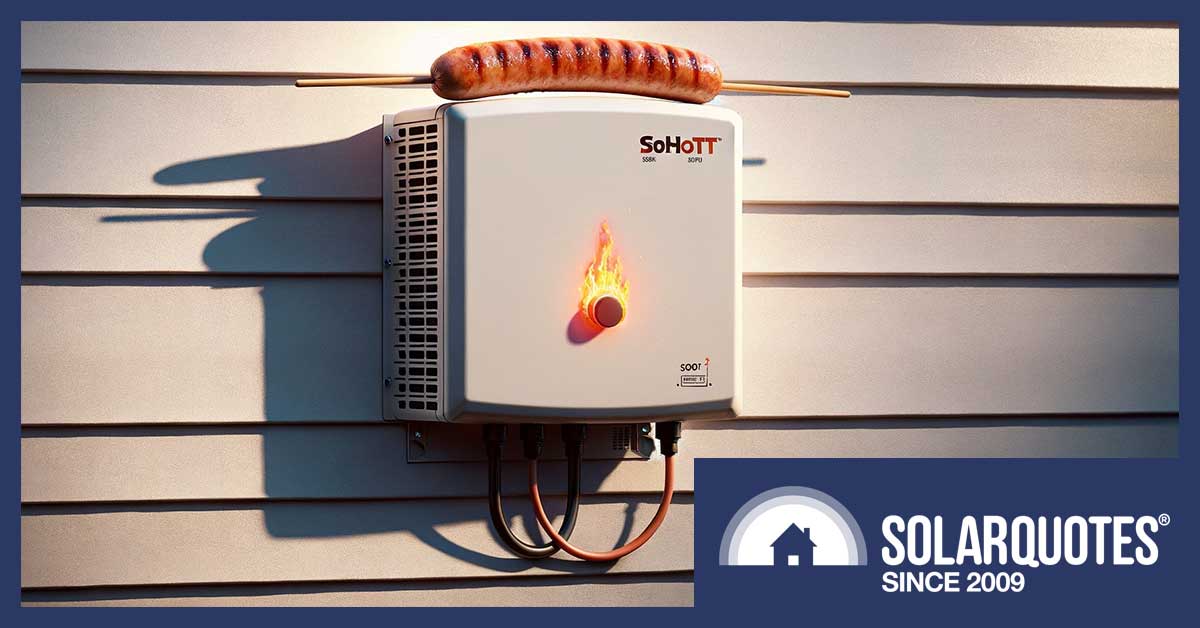
As the mercury climbs and solar yields improve around the Summer solstice, spare a thought for your inverter, steadfastly sweating away on the wall. High temperatures aren’t just an inconvenience, they’re an electronic health hazard, shortening the lifespan of your inverter. Read on while I explain how heat saps your inverter’s efficiency—and your wallet.
Electronics Hate Heat
Anything electrical doesn’t cope well with heat.
Solar inverters detect when they’re getting too hot and throttle back, converting less solar DC into AC electricity, which is a shame when you need that energy to run the air conditioning.
This is called ‘temperature derating’ and is smart design because it saves this expensive piece of kit from burning itself out1.
Fan-Forced Cooling Is Best
There is much to be said for proper thermal management with a fan, so I have always been keen on Selectronic and Fronius inverters. Even when the competition likes to market their devices as being practically silent by comparison, the roar of a Fronius fan reassures me there’s some work being done by a machine that will last longer because it runs cooler. Best of all it means more yield harvested.
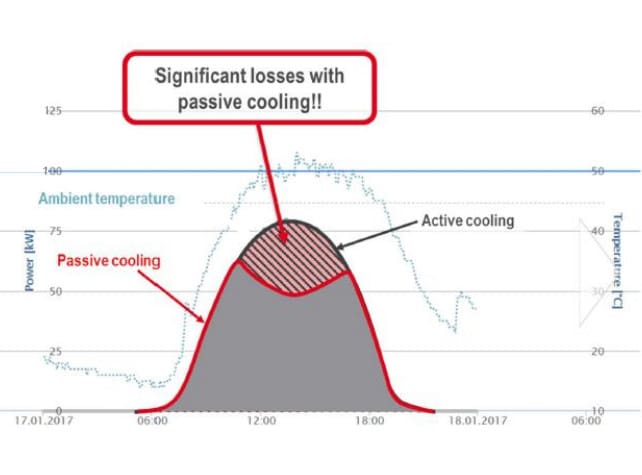
Fan-forced cooling means more energy than passive cooling, according to Fronius. Image credit: Fronius
If you look under the bonnet of a modern car, you’ll find that the radiator they use to manage the heat from a combustion engine is broad, thin, lightweight and fan-forced. They don’t just hang a big heavy hunk of finned aluminium on the front and hope there’s a quiet breeze to cool the inefficient heatsink.
Fun fact: According to a Fronius whitepaper the fans for a Fronius inverter never run at full speed in Australia. The scorching Aussie heat de-rates the output of solar arrays enough that the inverter doesn’t have to deal with really high solar inputs found in Austria’s snowy alpine regions.
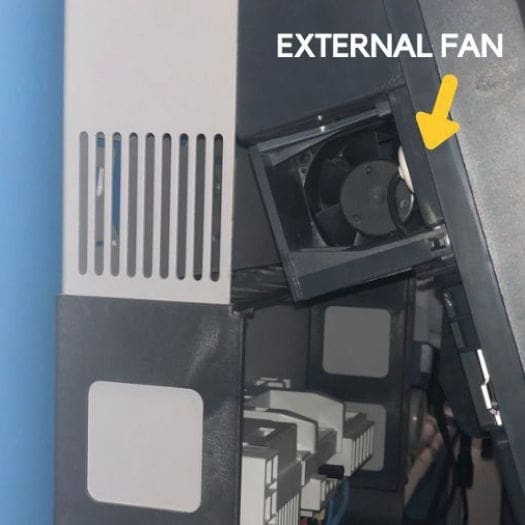
A Fronius “snapinverter” series inverter partially opened to reveal the cooling fan that makes all the racket.
The latest Gen24 Fronius inverters have a bigger, slower and much quieter fan than their ‘snapinverter’ predecessors, plus enough recycled aluminium to account for 328 beer cans, I’m assured.
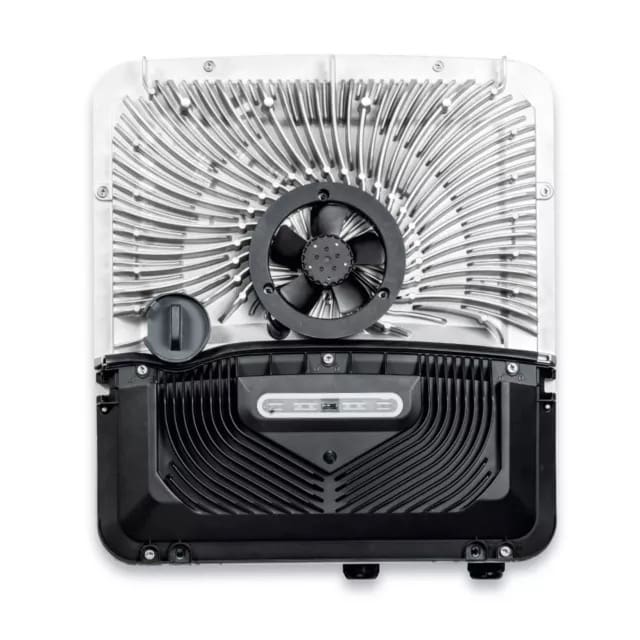
The internals of a Fronius Gen24 inverter.
Perhaps it’s telling that after years of solid alloy silence, the Sungrow inverter (3 phase 15kW) I installed recently has a fan stuck quietly on the back, too.
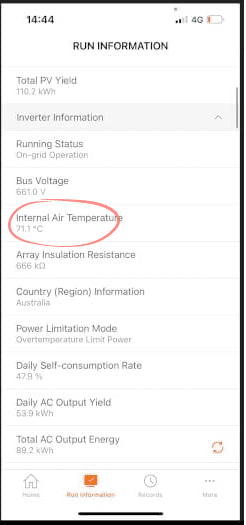
Real-world conditions are displayed on an app in Darwin vs the instructions. Note 71°C internal temperature causing “Power Limitation Mode”. This customer ran an oscillating fan on hot days to keep the inverter online.
Small Spaces Need Ventilation
Electric motors are often specified to have 20°C temperature rise so on a 40° day it’s perfectly normal for say a pool pump to run at 60°C. That’s too hot to lay your hand on comfortably. Some solar inverters are much the same. They’re obliged by law to put “hot surface” warning stickers on them.
I have seen first hand where wall paint has been discoloured by hot heat sinks, while inverters have led short lives because they’ve been kept like naughty children in a cupboard under the stairs. In that particular instance we replaced the inverter and gave it a bathroom exhaust fan, plugged into a home brewers thermostat, to keep the cupboard fresh.
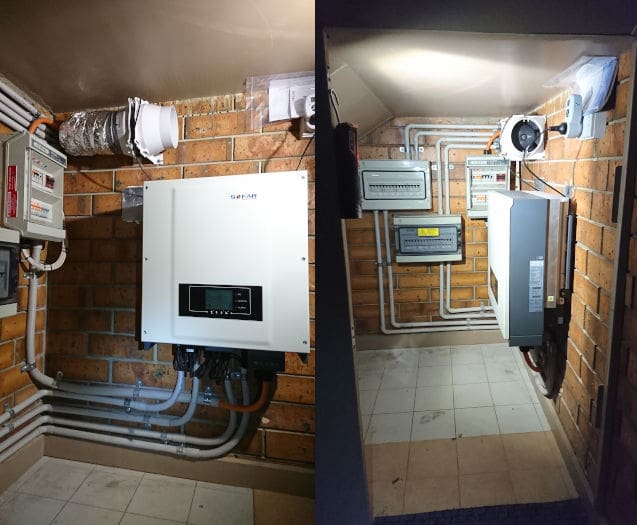
Like a bathroom heat lamp shut in a box, at 96% efficiency, this 30kW machine can throw off a lot of energy. The exhaust fan should keep the cheap replacement inverter cool, though.
How To Keep The Sun Off Your Inverter
For many years, the rules for solar (Clause 8.1.1.2) have dictated inverters can’t go on the North side of the house in full sun. Radiant heat from outside and electrical heat from inside just bakes them.
Better installers resort to a “hammerbarn awning”, which is better than nothing. Realistically, they offer patchy protection, especially if your inverter calls for 500mm of clearance from what’s supposed to protect it.
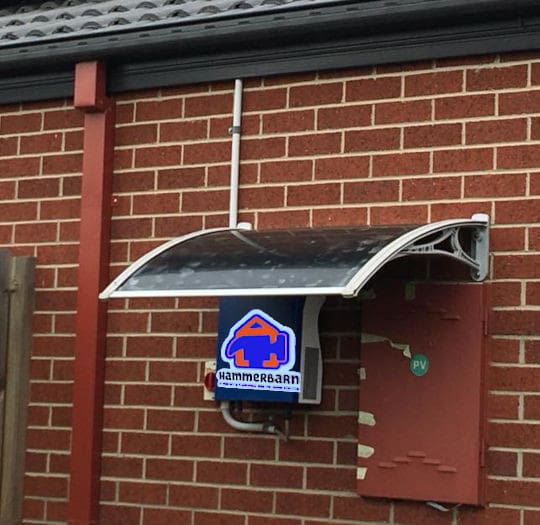
This awning would want a gap against the wall to let the hot air out.
There are many better options available, which are more durable than a cardboard box, however they’ll add $300 – $450 to the cost of your system. If you’re just a little handy, grabbing a $30 shade sail, screwing it to the eave or wall above the inverter & then pegging it to the ground or fence is a great idea.
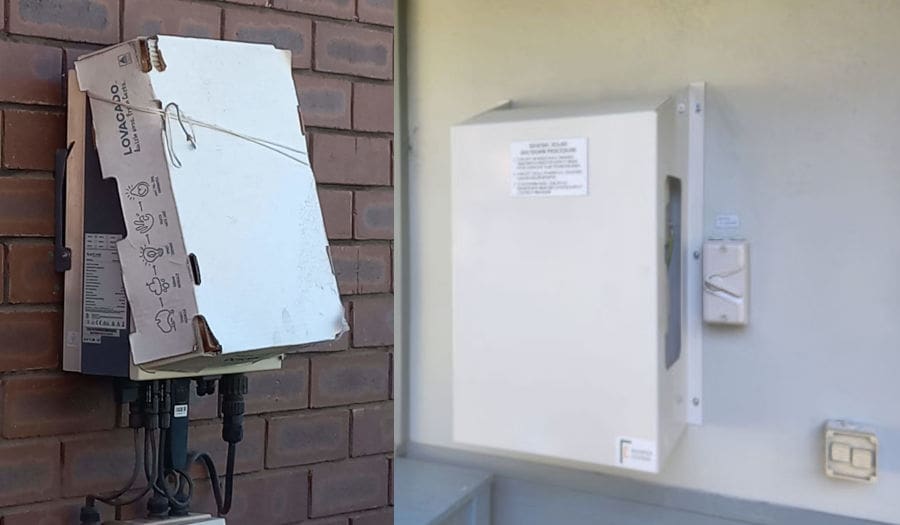
You get what you pay for with inverter covers
I’ve done this experiment, and shade cloth can easily lower the wall temperature by 10°C. Just stopping rain strikes is surprisingly good for the longevity of the inverter, labels & more importantly, DC isolators if you have them.
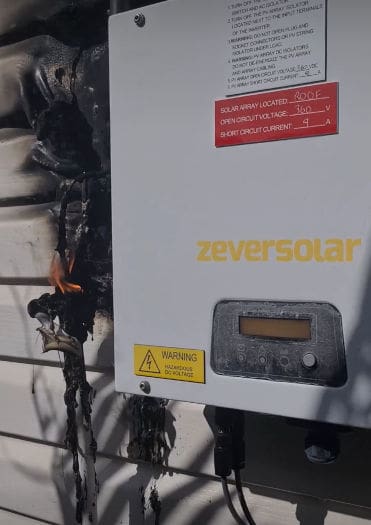
That flaming mess was a DC isolator, an item worth having checked by qualified people. These days, inverter makers build them for much better quality & safety.
A Cool Garage Is Best
Installing complex electrical equipment out of the weather is also a good idea. Most grid-connect inverters are pretty robust, but some aren’t. Even if it’s sealed to IP66 ratings, though, exposure to the elements simply doesn’t do things any good. I’ve always advised people that putting your inverter where it will be seen regularly is also a great way to ensure it keeps working.
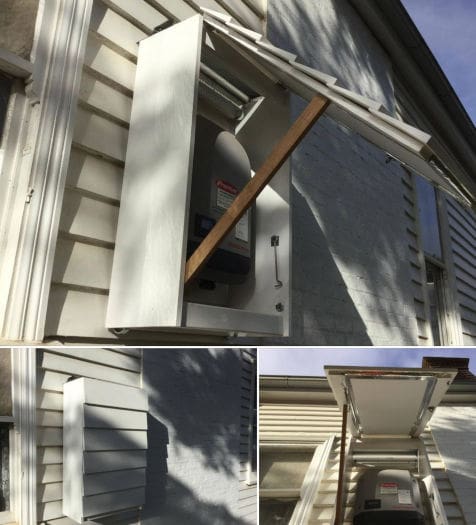
Heritage rules are sometimes genius.
Dos And Don’ts
- Don’t wrap an inverter with insulation or keep it in a sealed box
- Do Put it in the shade
- Do keep an eye out for dirt, dust, wasps, geckos and other wildlife.
- Remember that professional servicing can identify problems before they become a disaster.
- Many network connection agreements actually oblige you to have an electrician test your system and issue a compliance certificate every five years.
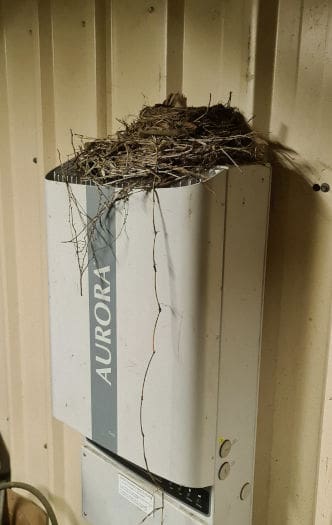
Boiled eggs, anyone?
Footnotes
- For comparison, when the generator on my 100-year-old car has a minor malfunction, it’s more likely to toast the hand-wound armature, burn the insulation from the fields and, in a final act of self-immolation, throw molten solder everywhere. It’s a lot of heartache for a machine that’s only ever good for about 200 watts. ↩

 RSS - Posts
RSS - Posts



What about micro-inverters on the panels themselves?
Not a problem with my 65 Enphase 7a micro inverters for the past 2.5 years. Designed for extreme heat and cold. Far greater than what Melbourne can offer.
Good to know, I have Enphase as well. Obviously they’re naturally shaded, being on the underside of the panel, though I guess a roof can still get very hot. But if they’re designed to deal with it, all the better.
“According to a Fronius whitepaper the fans for a Fronius inverter never run at full speed in Australia” – I call BS, need to get Fronius techs around to my place then, Fronius Primo 8.2 in my garage pushing out 7.6kw in 40C ambient and the fan is reported as (and sounds like) running at 100%. And we’re still a degree of 41C Max for the day…..
Having a cooling fan on one hand seems a great idea to give the inverter more cooling so that it can run more efficiently, however by designing the thing to run with a fan are we now reliant on a temperature sensor to shut down the whole unit if the fan slows too much or stops ? ie are we introducing a fire risk for the sake of a little better performance ?
The cooling fans will have a finite life of around 40000 hours, provided they are kept clean and checked and of decent quality.
So you need to install the inverter so it is easy to access the fan to change it out. By this I mean the wiring is not in the way and other items are not too close. The fan is probably the item which will fail first. It should probably be changed at 40000 hours as preventive maintenance as it’s failure could cause other electrical components to fail.
Fans on speed controllers for electric motors running continuously start failing after 3-4 years and are often installed near the floor and have to be completely disconnected to change a cooling fan on the bottom of the unit. So a simple job is made difficult by poor placement.
Hi Michael.
My Sungrow 10RT Inverter is mounted inside my garage on an east facing wall in south Queensland. It has run white hot since installation. I raised my concerns with both the installer and Sungrow themselves who suggested this is ‘normal’.
As a retired Marine Electrical engineer who worked mainly in the tropics I am cognisant of the effects of heat on electrical equipment so I took an old 100mm computer cooling fan and mounted it temporarily on top of the Inverter and it seems to work very well. I can now leave my hand on it at midday comfortably for several seconds I use a mains timer to switch a 12v Power Adapter so the fan only runs during daylight hours, the fan consumption isn’t worth worrying about.
I now intend to build a shroud to fit neatly over the top of the Inverter and upgrade to a 120mm fan.
Stan
hi stan
i also have a sungrow 8kwt inverter and from day 1 it ran very hot ,my answer to the problem was to get a box fan 240v on a timer, and install it in a housing and then attach it to the front of the inverter and works a treat .inverter is installed indoors so weather is not an issue
lew
My Fronius IG30 is still going strong after 15 years, no doubt due to it being inside an insulated room and its internal fan which I enjoy hearing singing along as generation increases.
I’ve only just discovered it is only about 90% efficient though.
Any quality Solar Company will advise that the inverter go in the garage, under a carport or on the Southern side of the house.
You may pay more, but it is well worth it in the short term for the system’s efficiency, and in the long run for aesthetics.
The south side of my house faces the street. Grid power is supplied from a shared secondary pole in my backyard and the meter box is on the east wall, near said pole. My garage is separate and to the rear on the western side.
This hypothetical Solar Company will struggle to convince anyone to put an inverter that far from the meter.
“According to a Fronius whitepaper the fans for a Fronius inverter never run at full speed in Australia. The scorching Aussie heat de-rates the output of solar arrays enough that the inverter doesn’t have to deal with really high solar inputs found in Austria’s snowy alpine regions.”
I read the whitepaper and this statement still doesn’t make any sense. I have 13.2kW of Jinko 54HL4R-V 440W panels connected to a 10kW inverter and the inverter saturates at 10.2kW ouput for 5 hours a day, even during our 39oC day yesterday (NSW Hunter Valley).
Surely if my peasant grade Jinko’s can max out my inverter, the fancy panels typically connected to a Fronius inverter in a standard 30% overprovision would be able to saturate the inverter even in high ambient temps and max out the fan speed.
The life-shortening effect of overtemperature is dramatic. Electronic component failures follow the Arrhenius equation, so in practice, the lifetime approximately halves for each 10 degC of temperature rise. Thus the benefit of a sunshade and or fan is substantial.
Especially in EVs, there is increasing use of Silicon carbide semiconductors, as they are more temperature resistant, but especially in inverters, it is the wet electrolytic capacitors which are intrinsically most susceptible. Even if the print on the component sleeve says “120 degC”, that only means it’ll take longer for it to let the magic smoke out. (Inverter capacitors also heat up due to the high frequency ripple current they must endure, and so have to be special “low ESR” types in order to survive at all. Keeping them cooler is a good investment.)
My inverters & MPPTs are going into a workshop, which will be airconditioned if it goes above 30 degC. I’ve fished out some big computer fans to add to the battery box, as LiFePO₄ also lasts longer if not cooked, and charging from the 27 kW array will be able to give it heaps. (My installer says the REC 470 w panels are not available here yet, so we have to make do with 420 W panels, losing 3 kw or so. With the EV arriving tomorrow, it’s time to just whack it up, or I could end up charging the EV with a petrol generator. That wouldn’t be acceptable.)
A spot-on comment with respect to temperature.
A useful development is the replacement of electrolytics with polypropylene capacitors. For industrial applications, especially higher powers and three phase, these are widely used. These are now appearing in sizes up to hundreds of uF. A residential example is the SolarEdge HD-Wave Genesis series. Ceramic capacitors are also appearing up to about 50uF so these will really be attractive in applications like micro inverters.
It is useful to look at the PV array string length voltage as some inverters have their best efficiency if the MPPTs do not work too hard. Lower losses mean lower temperatures. My 11-year-old SMA enjoys shade and a string voltage of around 320V. Never missed a beat.
I’m really frustrated by this! My installer put our Fronius Primo 5.0-1 on the West wall of our house and it’s in the blazing sun (ok it’s Melbourne so maybe not blazing) all afternoon. After a year or so we started to get “derating due to over temp” error messages. Got onto the installer who insisted there was no problem with the inverter being in the sun and the messages were unrelated. But they only happened when it was a hot day and the inverter was in the sun! In the end they came out and replaced some components inside the inverter and still insisted there was no issue with it being in the sun. They even passed on an email from Fronius saying the same. Thankfully we have a long extended warranty so we shall see, but reading articles like this really make you wonder.
A great article. I love getting all this information. So…a simple question; everything is in our garage – however the geckos as well. What do we do about those pests that are everywhere here in SE Qld?
Mine is under cover in the carport with a standing fan blowing over it which seems to keep the temperature down.
I live on the Mid North Coast and had a similar problem with gekos sitting on top of my Fronius inverter in my garage. I now put moth-balls on the top of the inverter and the gekos keep off it. 😊
I had a Solax 5Kw inverter that recently ( Dec 2024 ) died. I was very fortunate that Solax honoured the warranty, as it had only just ticked over the 5 years a couple of months before. So I have a brand new replacement that I hope to get at least another 5 years out of. Its positioned on the south side of the house, so is usually in the shade, but I had also macgyvered a frame and cover that keeps it out of the rain and provides extra shading as well, all while leaving air flow to the heat sink. Even though it does not have active cooling, like the Fronius fan, it stays relatively cool. I find that our 6.6Kw solar array always “maxes out” so that our power generation bell curve is “clipped”. i.e. it reaches a maximum output earlier, and sustaining it for longer. Up until the original inverter failed, the unit ran trouble free.
I have just had a Goodwe Inverter installed on my North Facing wall, is this legal or should l get it moved as that wall gets all the heat during the day?
It’s legal, just poor practice.
There is another way.
I purchased the Sungrow 5kw inverter which is passive cooled via the finned heat sink on the back. The manufacturer reckons this is adequate and they’re probably right-ish.
But if it is designed to operate on a passive cooling principal then imagine the benefit of additional fan cooling.
Its easy cheap and a fun project.
To that end I built an alloy fan box containing 4x 0.2w computer fans and mounted this box under the inverter. The fans are connected via a solar regulator and battery to 2 x 10w PV panels. The sun shines and the fans kick in, sun goes down fans stop. Around the sides of the inverter and curled over the top are 1.2mm fabricated alloy baffles. This is the same principal as an air cooled aircraft engine where positive pressure is created by a sealed baffle system to maximise airflow around the cooling fins.
The failsafe redundancy is if the fans failed there is still enough opening to allow convective updraft cooling
Works very well and contains operating temps to within 15c of ambient air temp.
My 10 kW Sungrow inverter has only recently started running at full power and exporting more than 1.5 kW to the grid, which I’m guessing means that my electricity supplier has finished a remote upgrade of the meter to make it compatible with flexible exports. Anyway, when the inverter is running at full power, it gets quite hot (not burn-your-fingers hot but uncomfortable to touch) and also emits a high pitched sound, which can be quite unpleasant on the ear, and there’d be a risk of a headache with prolonged exposure I imagine. The inverter is located in the garage. Not too much of a problem, as I’m rarely in the garage for prolonged periods and the inverter is perfectly quiet when not pumping out a full 10 kW of energy, but I feel like it’s something to keep an eye on. Please let me know if you have any helpful thoughts.
hi
Lew here
l have the same inverter and did the following , purchased a ceiling exhaust fan cheap $20 or so ,made a box frame out of 2×1 timber , put it over the frame of the inverter (no walls on it) and fitted the fan into 1 side of it, then inverted the fan to blow onto the inverter and put it on a 240 volt time and voila , cool inverter
hope this helps
lew
Hi Lew,
Arlec also make a “temperature controlled timer” that can be used to switch things on and off. You and I would call it a plug in thermostat.
Problem is that it has a volatile memory, so a power outage wipes the temperature you’ve adjusted to and it falls back to 20°C as the set point.